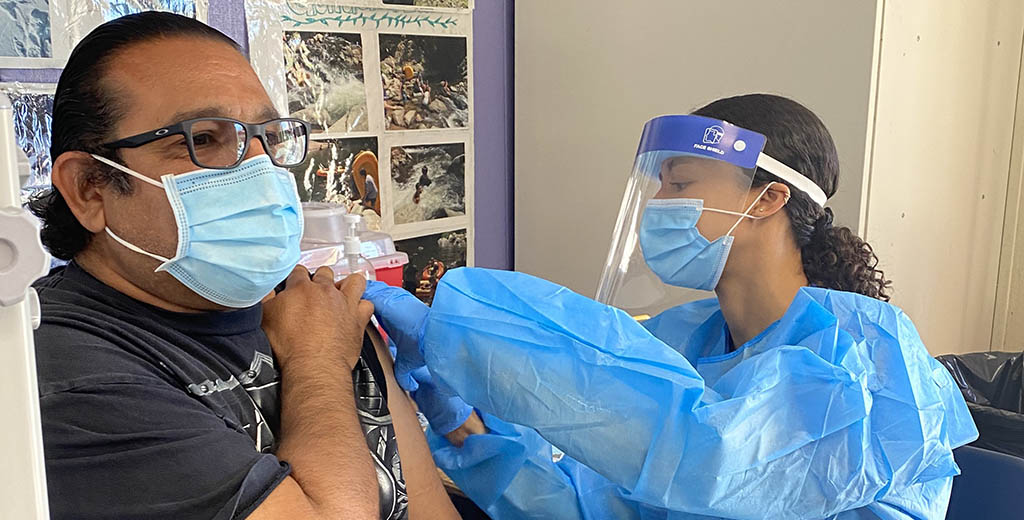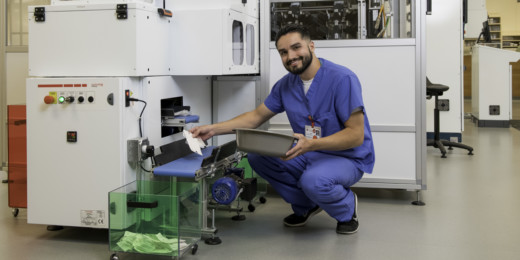On a bright Saturday morning, hundreds lined up outside a Palo Alto church, eager for a COVID-19 vaccine. Sriyani Sinhala, a Sunnyvale resident who works as a nanny, was the first to arrive -- at 4:30 a.m. -- to secure her place in line.
"I'm excited because I finally did it," she said while relaxing in the church parking lot after being inoculated by a Stanford medical student. "Now I'm finally safe. I feel much better."
Like many people that day, Sinhala tried desperately to obtain the shot, repeatedly calling local pharmacies and the Santa Clara County clinic, to no avail. She has no health insurance and her livelihood depends on remaining COVID-free, she said.
She was among the more than 5,300 who have benefited from the new COVID Crew program, in which Stanford medical students volunteer to vaccinate people in underserved communities, partnering with the nonprofit Roots Community Health Center.
The effort is an outgrowth of the Stanford Flu Crew program, launched in 2001 by San Jose family physician Walter Newman, MD, to protect the health of farmworkers in Monterey County. The program has since expanded to Santa Clara and San Mateo counties, where students have provided an estimated 30,000 to 40,000 flu shots over two decades to those who lack ready access to care, including homeless residents.
"We want to play an active role in the community that is hosting us. We want to give back in every way possible in terms of health equity," said first-year medical student Lucy Ma, who co-directs the program with fellow students Tori Harbour and Ana Boncompagni.
Boncompagni, who is a Brazilian immigrant, said she became involved in the program because she knows from personal experience how difficult it can be to access the U.S. health care system, especially when language or financial barriers exist. She said volunteering during the pandemic has been particularly meaningful.
"Going into the community and doing the physical work in person, getting into the clinical aspect of care that we love so much, it's a great reminder of our passion for medicine. We are doing basic human needs work that is urgent," she said.
Because the medical students were already trained to administer flu shots, it was easy for them to pivot to providing COVID-19 vaccines when they became available. About 200 Stanford medical students are participating in the program, with many clamoring for the opportunity to be involved.
"The sign-up list was full within an hour," said first-year medical student Quan Tran. "I think we're just ready to have society move on from the pandemic."
Pat Fast, MD, PhD, an adjunct clinical associate professor in pediatrics and faculty adviser to the program, said few medical schools have projects of this kind.
"It's pretty unusual in that it's a student-led vaccination program," said Fast, who is a vaccine expert. "It's not a usual thing for students to do."
The trainees began giving COVID-19 shots in February in a collaboration with Roots Community Health Center, a Bay Area nonprofit community clinic that offers accessible, culturally sensitive care to low-income and uninsured residents. The students provide the injections at Roots' sites twice a week and plan to partner with other nonprofits so they can reach more people.
Mary Nutting, a family nurse practitioner and clinical manager at Roots, said the group welcomes the students' help. "They're fantastic. They do a thorough job. They're efficient. We're happy to have them," she said.
On March 31 in East San Jose, hundreds of people formed a line around the block near the Sunrise Middle School, patiently awaiting their turn in the hot sun. It was a diverse crowd of mostly Latino, Black and Asian residents waiting for either first and second doses.
That day, Roots had 900 doses of the Moderna vaccine, which it obtained from Santa Clara County. Five Stanford medical students, gowned, gloved and masked, set up stations inside the school's well-ventilated cafeteria while Roots staff prepared syringes and screened patients.
Javier Vazquez, a San Jose resident in his 50s, said he came at 7 a.m., eager to get his first shot.
"It's good that we're getting back to normal, but we have to be safe," said Vazquez, who supervises 60 restaurant and other workers at two San Jose malls. "I've been worried all this time. I have a few family members who have passed away because of COVID. We stay home all the time, though we have to go to work."
He was elated to receive the shot. "I'm feeling great. I'm so excited."
People were similarly upbeat at the University AME Zion Church in Palo Alto, a historically Black church, where students provided vaccines over several weekends. Among those who came on a recent Saturday was Magrissa Funnie, a food service worker in Palo Alto.
"I've been waiting for this for a while. It's been a long time coming," Funnie said. "I'm Black. I'm 60 and an essential worker. That puts me in all [risk] categories."
Getting the shot, she said, "was amazing. It gives me a great sense of relief."
The three student leaders for Stanford Medicine's COVID Crew recently received the San Francisco Bay Area Schweitzer Fellowship, which recognizes projects that address unmet needs in the community. Their goal is to use the $6,000 grant to start their own COVID-19 vaccination clinic, much like the flu clinics, with a focus on the farmworker and the Latino communities in the Bay Area, Boncompagni said.
"It's just great to be part of this historic vaccination effort," said Harbour, a first-year student leader.
Image by Ruthann Richter of Stanford medical student Tori Harbour, giving a second dose of the Moderna COVID-19 vaccine to Miguel Mariscal of San Jose at Sunrise Middle School in March 2021.




